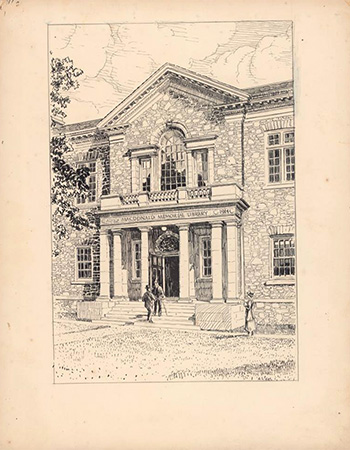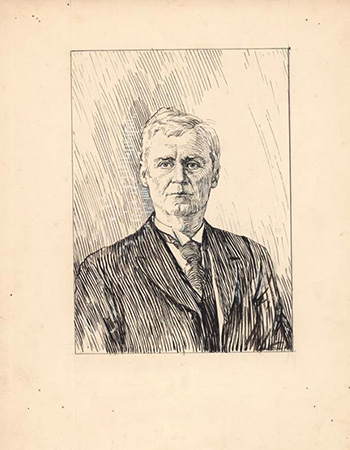It’s not every day that drawings by a Group of Seven artist are discovered — but that’s what happened when Dalhousie University Archives assistant Jennifer Lambert recently went searching for something in the oversize collection.
“When I opened the lid and saw the word ‘Lismer,’ I knew I had found something very special,” says Lambert.
Inside the box were more than forty pen and ink drawings of various Dalhousie buildings, professors, presidents, and members of the Board of Governors — all drawn by prominent Canadian artist and Group of Seven member Arthur Lismer (1885-1969).
Looking back a century ago
The drawings were executed in 1918 when Lismer lived in Halifax and was serving as Principal of the Victoria College of Art (now NSCAD University). Lismer was commissioned by Dalhousie to create a series of illustrations for the book One Hundred Years of Dalhousie 1818–1918.
 “The timing of this find, with Dal 200 right around the corner, is nothing short of remarkable,” said Donna Bourne-Tyson, university librarian. “As soon as the illustrations were found, we began a series of consultations to assess the value of the drawings and determine the best place to house these treasures, while providing access for researchers and the appropriate level of security.” (Left: The Macdonald Building)
“The timing of this find, with Dal 200 right around the corner, is nothing short of remarkable,” said Donna Bourne-Tyson, university librarian. “As soon as the illustrations were found, we began a series of consultations to assess the value of the drawings and determine the best place to house these treasures, while providing access for researchers and the appropriate level of security.” (Left: The Macdonald Building)
Staff in the Archives quickly got to work digitizing them and creating a finding aid so they will be discoverable as part of the Dal Libraries collections.
Because the illustrations were done by such a well-known artist, questions about the value of the pieces immediately come to mind.
“These illustrations, while interesting, are commercial art, not fine art,” said Peter Dykhuis, director of the Dalhousie Art Gallery. “Arthur Lismer did the drawings for a specific purpose; you can see the areas where he used gouache to remove some of the lines he drew in preparation for the publication process, so they’re not the kind of thing you’ll see hanging in the gallery. Having said that, the illustrations are certainly interesting to researchers and Arthur Lismer fans.”
 A suspected find
A suspected find
For those reasons, the drawings will stay in the Archives, though this time their exact location will be duly noted. Researcher Alan Ruffman, a Dal alumnus, honorary research associate as well as adjunct professor in the Department of Earth Sciences, and an adjunct professor in the School of Planning, was convinced the Archives had the drawings and had been searching for them for since 2015. “I was glad I indulged my curious inclination that day in the oversize collection and opened the lid, finally solving the mystery of the location of the Lismer drawings,” says Lambert. (Right: Founding Dean of Law Richard Weldon)
Since the illustrations have been found, Lambert and her colleagues at the Archives have been collaborating with staff from the Dalhousie Art Gallery and Mr. Ruffman for details to include in the finding aid.
Discussions are underway to possibly exhibit the illustrations in the Dalhousie Art Gallery as part of its exhibition program in 2018. Digitized versions of the illustrations will appear in the publicly searchable University Archives catalogue soon.
For now, a selection of the illustrations are available to view on the Dalhousie Archives’ Facebook page.
This article is part of an ongoing series highlighting planning for Dalhousie’s 200th anniversary celebrations in 2018. For more information on Dal 200, visit dal200.ca.
Comments
comments powered by Disqus

